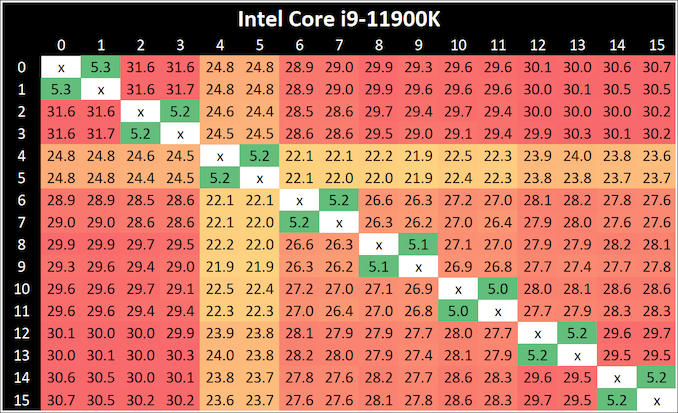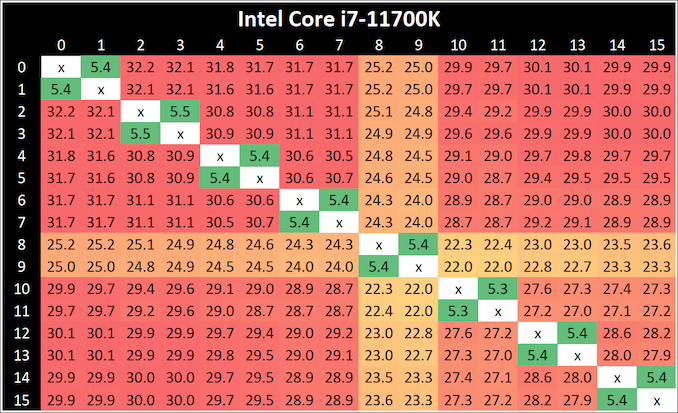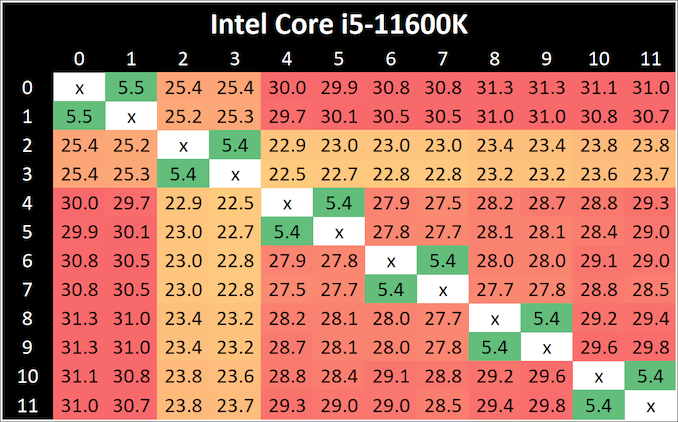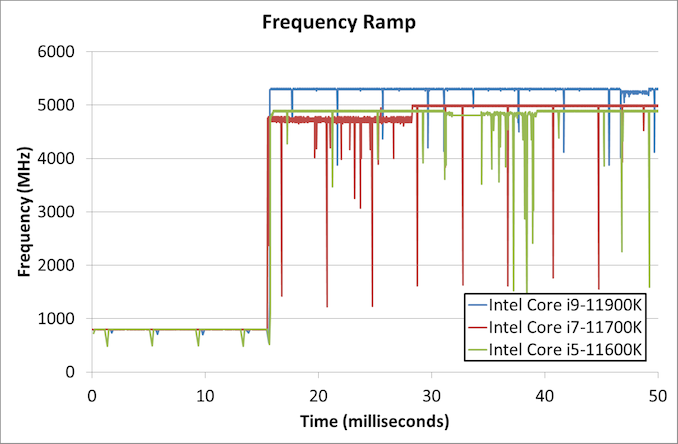Intel Rocket Lake (14nm) Review: Core i9-11900K, Core i7-11700K, and Core i5-11600K
by Dr. Ian Cutress on March 30, 2021 10:03 AM EST- Posted in
- CPUs
- Intel
- LGA1200
- 11th Gen
- Rocket Lake
- Z590
- B560
- Core i9-11900K
CPU Tests: Microbenchmarks
Core-to-Core Latency
As the core count of modern CPUs is growing, we are reaching a time when the time to access each core from a different core is no longer a constant. Even before the advent of heterogeneous SoC designs, processors built on large rings or meshes can have different latencies to access the nearest core compared to the furthest core. This rings true especially in multi-socket server environments.
But modern CPUs, even desktop and consumer CPUs, can have variable access latency to get to another core. For example, in the first generation Threadripper CPUs, we had four chips on the package, each with 8 threads, and each with a different core-to-core latency depending on if it was on-die or off-die. This gets more complex with products like Lakefield, which has two different communication buses depending on which core is talking to which.
If you are a regular reader of AnandTech’s CPU reviews, you will recognize our Core-to-Core latency test. It’s a great way to show exactly how groups of cores are laid out on the silicon. This is a custom in-house test built by Andrei, and we know there are competing tests out there, but we feel ours is the most accurate to how quick an access between two cores can happen.
All three CPUs exhibit the same behaviour - one core seems to be given high priority, while the rest are not.
Frequency Ramping
Both AMD and Intel over the past few years have introduced features to their processors that speed up the time from when a CPU moves from idle into a high powered state. The effect of this means that users can get peak performance quicker, but the biggest knock-on effect for this is with battery life in mobile devices, especially if a system can turbo up quick and turbo down quick, ensuring that it stays in the lowest and most efficient power state for as long as possible.
Intel’s technology is called SpeedShift, although SpeedShift was not enabled until Skylake.
One of the issues though with this technology is that sometimes the adjustments in frequency can be so fast, software cannot detect them. If the frequency is changing on the order of microseconds, but your software is only probing frequency in milliseconds (or seconds), then quick changes will be missed. Not only that, as an observer probing the frequency, you could be affecting the actual turbo performance. When the CPU is changing frequency, it essentially has to pause all compute while it aligns the frequency rate of the whole core.
We wrote an extensive review analysis piece on this, called ‘Reaching for Turbo: Aligning Perception with AMD’s Frequency Metrics’, due to an issue where users were not observing the peak turbo speeds for AMD’s processors.
We got around the issue by making the frequency probing the workload causing the turbo. The software is able to detect frequency adjustments on a microsecond scale, so we can see how well a system can get to those boost frequencies. Our Frequency Ramp tool has already been in use in a number of reviews.
From an idle frequency of 800 MHz, It takes ~16 ms for Intel to boost to the top frequency for both the i9 and the i5. The i7 was most of the way there, but took an addition 10 ms or so.














279 Comments
View All Comments
mitox0815 - Tuesday, April 13, 2021 - link
Discounting the possibilty of great design ideas just because past attempts failed to varying degrees is a bit premature, methinks. But it does seem odd that it's constantly P6-esque design philosphies - VERY broadly speaking here - that take the price in the end when it comes to x86.blppt - Tuesday, March 30, 2021 - link
Even Jim Keller, the genius who designed the original x64 AMD chip, AND bailed out AMD with the excellent Zen, didn't last very long at Intel.Might be an indicator of how messed up things are there.
BushLin - Tuesday, March 30, 2021 - link
It's still possible that a yet to be released Jim Keller designed Intel CPU finally delivers a meaningful performance uplift in the next few years... I wouldn't bet on it but it isn't impossible either.philehidiot - Tuesday, March 30, 2021 - link
Indeed, it's a generation out. It's called "Intel Dynamic Breakfast Response". It goes "ding" when your bacon is ready for turning, rather than BSOD.Hifihedgehog - Tuesday, March 30, 2021 - link
Raja Koduri is a terrible human being and has wasted money on party buses and booze while “managing” his side of the house at Intel. I think Jim Keller knew the corporation was a big pander fest of bureaucracy and was smart to leave when he did. The chiplet idea he brought to the table, while not innovation since AMD already was first to market, will help them to stay in the game which wouldn’t have happened if he hadn’t contributed it.Oxford Guy - Saturday, April 3, 2021 - link
Oh? Firstly, I doubt he was the exec at AMD who invented the FX 9000 series scam. Secondly, AMD didn’t beat Nvidia for performance per watt but the Fury X coming with an AIO was a great improvement in performance per decibel — an important metric that is frequently undervalued by the tech press.What he deserves the most credit for, though, is making GPUs that made miners happy. Fact is that AMD is a corporation not a charity. And, not only is it happy to sell its entire stock to miners it is pleased to compete against PC gamers by propping up the console scam.
mitox0815 - Tuesday, April 13, 2021 - link
The first to the x86 market, yes. Chiplets - or modules, however you wanna call them - are MUCH much older than that. Just as AMD64 wasn't the stroke of genius it's made out to be by AMD diehards...they just repeated the trick Intel pulled off with their jump to 32 bit on the 386. Not even multicores were AMDs invention...I think both multicore CPUs and chiplet designs were done by IBM before.The same goes for Intel though, really. Or Microsoft. Or Apple. Or most other big players. Adopting ideas and pushing them with your market weight seems to be much more of a success story than actually innovating on your own...innovation pressure is always on the underdogs, after all.
KAlmquist - Wednesday, April 7, 2021 - link
The tick-tock model was designed to limit the impact of failures. For example, Broadwell was delayed because Intel couldn't get 14nm working, but that didn't matter too much because Broadwell was the same architecture as Haswell, just on a smaller node. By the time the Skylake design was completed, Intel had fixed the issues with 14nm and Skylake was released on schedule.What happened next indicates that people at Intel were still following the tick-tock model but had not internalized the reasoning that led Intel to adopt the tick-tock model in the first place. When Intel missed its target for 14nm, that meant it was likely that 10nm would be delayed as well. Intel did nothing. When the target date for 10nm came and went, Intel did nothing. When the target date for Sunny Cove arrived and it couldn't be released because the 10nm process wasn't there, Intel did nothing. Four years later, Intel has finally ported it to 14nm.
If Intel had been following the philosophy behind tick-tock, they would have released Rocket Lake in 2017 or 2018 to compete with Zen 1. They would have designed a new architecture prior to the release of Zen 3. The only reason they'd be trying to pit a Sunny Cove variant against Zen 3 would be if their effort to design a new architecture failed.
Khenglish - Tuesday, March 30, 2021 - link
I've said it before but I'll say it again. Software render Crysis by setting the benchmark to use the GPU, but disable the GPU driver in the device manager. This will cause Crysis to use the built-in Windows 10 software renderer, which is much newer and should be more optimized than the Crysis software renderer. It may even use AVX and AVX2, which Crysis certainly is too old for.Adonisds - Tuesday, March 30, 2021 - link
Great! Keep doing those Dolphin emulator tests. I wish there were even more emulator tests